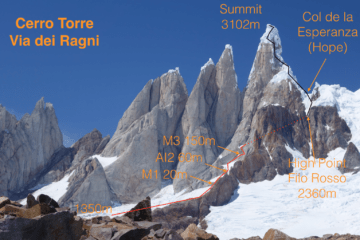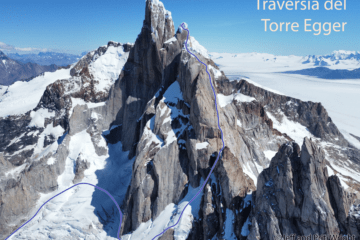The Case for a Alpine Sabbatical:
The year 2020 will be the first Gap Year for Alpinists Jeff and Priti Wright who’s alpine pursuits have until now been relegated to weekends and vacation days. For two years, they have planned and saved for their Sabbatical. This article will cover some of the lessons and steps for planning your own Gap Year.
Words and images by Jeff and Priti Wright. Photo by Tom Evans as credited.

Alpine Access Ease
Alpinism on the world’s finest peaks has changed dramatically over decades, allowing some objectives to be boxed up into bite-sized packages of unsurprising experiences. Even career professionals like us now have the opportunity to cling to faces on hallowed peaks within the constraints of our full-time jobs. The accessibility of the alpine has incessantly increased over the past few decades with the reliability of weather forecasting (even in Patagonia), the development of roads and towns closer to the High Hills, and the security of SOS devices and rescue infrastructure. No longer does a Patagonian expedition require river fording, mule packs, and months of waiting out the planet’s nastiest weather under ramshackle boxes, but we’ve shown that even an ascent of Fitz Roy can be done in 9 days Seattle-to-Seattle and Cassin Ridge 10 days Seattle-to-Seattle with moderate forecasting prowess along with skills honed in our backyard, the Cascades. The Alps and Peruvian Andes, too, are even more accessible than ever. However, to focus on one specific objective in areas like Patagonia or to get really deep into the mountains, that takes time.

Smash ‘n Grabs
We’ve spent years perfecting the Smash ‘n Grab in the Alps, Patagonia, Alaska, and here at home in the Cascades. It relies on modern weather forecasting, checking local conditions through Instagram hashtags, and buying last minute plane tickets to catch the peak weather window. This optimizes not just our chance of success, but (more importantly) the amount of vacation time burned. This model has been very successful for us, and has taken us to many far-flung objectives over the past few years.
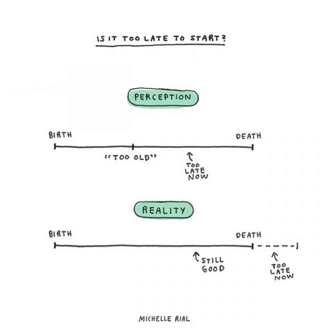
To get a taste of even more remote Remoteness, more alpine-y Alpinism, and more adventurous Adventure, we would need to take more time off than what our Corporate Overlords graciously dole out. To experience the richness of a culture, the languages, the spirit of the mountains, there is value in spending extended amounts of time. Time allows you to reach deeper into the mountain valleys to search for faces from which one cannot spot a trace of human impact, no scratch marks of Europe’s téléfériques, no light pollution from towns and villages.
Climbing Sabbatical
One significant downside to the Sabbatical model is that you’re not necessarily increasing your chances of success, you’re simply altering your lifestyle and goals for a trip. When we showed up in Patagonia in mid-February 2019 for the splitter window of the season, many folks were just catching their pre-planned flights back home after being in town for weeks and months with no significant weather windows. That’s why we’ve established that our goals for this upcoming trip would be more lifestyle-oriented as opposed to summit-oriented.
Find Inspiration; Make a Plan
“We saw this TED talk…”
the worst possible way to begin a sentence).
*Ahem*
We saw a short, motivational speech (still feels preachy) by an artist, Stefan Sagmeister called “The Power of Time Off” (easily Google-able) who spelled out his philosophy of regular, recurring Gap Years. This idea is a distinctly different philosophy than “Retiring Early” or “4-Hour Work Week”…to which neither of us particularly ascribe. We have talked about taking a Sabbatical for as long as we’ve been together. In fact, 10 years ago we had a sketch on the fridge for a Sabbatical savings goal. Planning never went beyond that sketch…until we sat down 8 years later and made a plan. Of course, the impetus to get serious about a Sabbatical for us was not just Sagmeister, but also a bombardment of close friends invading our Instagram with their plans for a Gap Year, their current adventures on their Gap Year, or their lessons from their Gap Year that they just finished. We could fill pages of names of friends who’ve done amazing extended trips just from the past 5 years. Turn FOMO (negative) into inspiration (positive)!
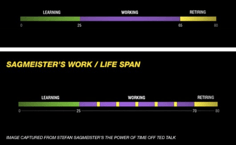
The idea of prioritizing experiences over materials transcends generational differences. It is theoretically possible to still have a successful career, a family, a house, and also take recurring, interspersed Sabbaticals instead of bundling them all up into Retirement at the end. We know several families who have successfully taken the whole gang on extended trips to learn new cultures, languages, and broaden their kids’ horizons (actually that phrase may be the worst way to end a sentence). Those experiences don’t have to be big and bold and international, either. You don’t need a snazzy Instagram account, and you don’t need to wake up counting how many new followers you got. It’s instead about collectively experiencing something together, for an extended period of time. But, heck, if you’re single, even easier!
Making a plan
It’s very simple, but it is the
MOST SERIOUS STEP
- Draft the Itinerary. Put together a draft itinerary and budget, then add a factor of safety (you’ll miss a lot of expenses in your draft), maybe 50%. Where do you want to go? How long? How many destinations? Are you living out of your Subie and travelling to America’s rad crags or are you going international? Sleeping in apartments, Airbnb’s, hostels, a van, a tent? Do you want to have extended stays in one locale, or travel continuously to pack in as much as you can? Other expenses to consider: long-term storage, breaking even on the rental of your house/condo, virtual mail delivery, travel/health/rescue insurance (or self insure?), flights, vaccinations, etc.
- Draft the Budget. List out all of your current bills and determine your discretionary income (this is called budgeting, if you’ve never tried it before…this was our first go at it!). Then figure out how much you can live off of your discretionary income while maintaining a sustainable standard of living. This is important! You can’t drastically change your lifestyle and start eating rice and ramen for every meal for XX number of years. You’ll likely burn out and abandon your plan. Once you determine how much you can save, calculate how long it will take you to save up for your Gap Year plan.
- Iterative Process. Repeat steps 1 and 2 until you reach equilibrium. Maybe you decide to do a cheaper itinerary ($3 a day goes a long way in SE Asia, just saying). Or maybe a shorter itinerary, or maybe change your start date. Decide all of this in one sitting until you are confident that you have a good draft plan! How urgent are you? Would you rather start your sabbatical sooner and take less time off, or do you have the fortitude to stick to a plan for 5 years. For us, two years is about the maximum we can dedicate to a specific plan. Any more than that, and we would get distracted and just decide to buy a boat instead, or throw all of our savings to our mortgage because suddenly that might sound more responsible.
Goals-Expectation-Style
As alpine climbing instructors, we teach about the importance of discussing these items as a team for each trip. Set the goals (optional, desired; reason for going in the first place), establish the expectations (mandatory items: safety, trip plan, gear, turnaround times, etc), then agree on a Style (i.e. for climbing: alpine vs expedition; i.e. for Sabbaticals: extended stays vs continuous travel).

List and Prioritize your Goals
Some dreams come first, some go on a K-Mart layaway. Don’t just list your climbing goals, but sprinkle in some other goals like: get abs, learn a language, do a handstand, absorb culture, meditate/pray (also maybe eat and love), get abs, educate yourself in a certain area, learn an instrument or a new sport, build your relationship with your travel buddy or significant other (if applicable), or just get abs.
Save Save Save
Stay on budget! You have a new discretionary income that is now significantly reduced from before (or maybe you were just winging it before). That shiny new cam has to get absorbed into this new daily budget. If you want a new rope, maybe eat ramen just for a week or so, but make sure it gets absorbed into the plan. Stick to the plan!
Career Goals?
We’ve been sloppily interchanging the phrases Gap Year and Sabbatical in this blog post; and indeed they are sort of interchangeable. Of course, your time off doesn’t need to be a year…it can be more or less. And it doesn’t need to be (paid or unpaid) time off that’s officially sanctioned by your employer…as the definition of Sabbatical implies. You can always just quit!
Still, a Sabbatical infers something much bigger than a vacation or just “time off”: personal enrichment, professional development, bigger mountains, harder routes, more dedicated training, etc. How disruptive is this for your career? Maybe 3 months is equally disruptive and awkward as a year, so why not take a year off? Check if your company offers a Personal Leaves of Absence. Companies are more and more beginning to offer these formally. Small startups may offer these informally. A sabbatical may come after many years with the same company; or at a time when you are between careers or considering a big life change.
Start the conversation early with your manager. Don’t complain to your boss about being “burnt out”. Instead, keep the conversation positive, discussing the benefits to your own life and maybe even the company. Did your employer hypothetically just go through two major aviation disasters from which it is currently hypothetically coping? Could you potentially help alleviate temporary headcount pressures?
Also, continue networking while away! Keep in contact and don’t be a stranger. Let your coworkers know how you’re doing, and that you’re looking forward to coming back (even if you have to grit your teeth while saying it).
Update your resume before you go. You’ll forget everything you’ve done within the first week of your fun-employment.
Develop a plan for covering your responsibilities while your gone. Start to wrap up loose ends.
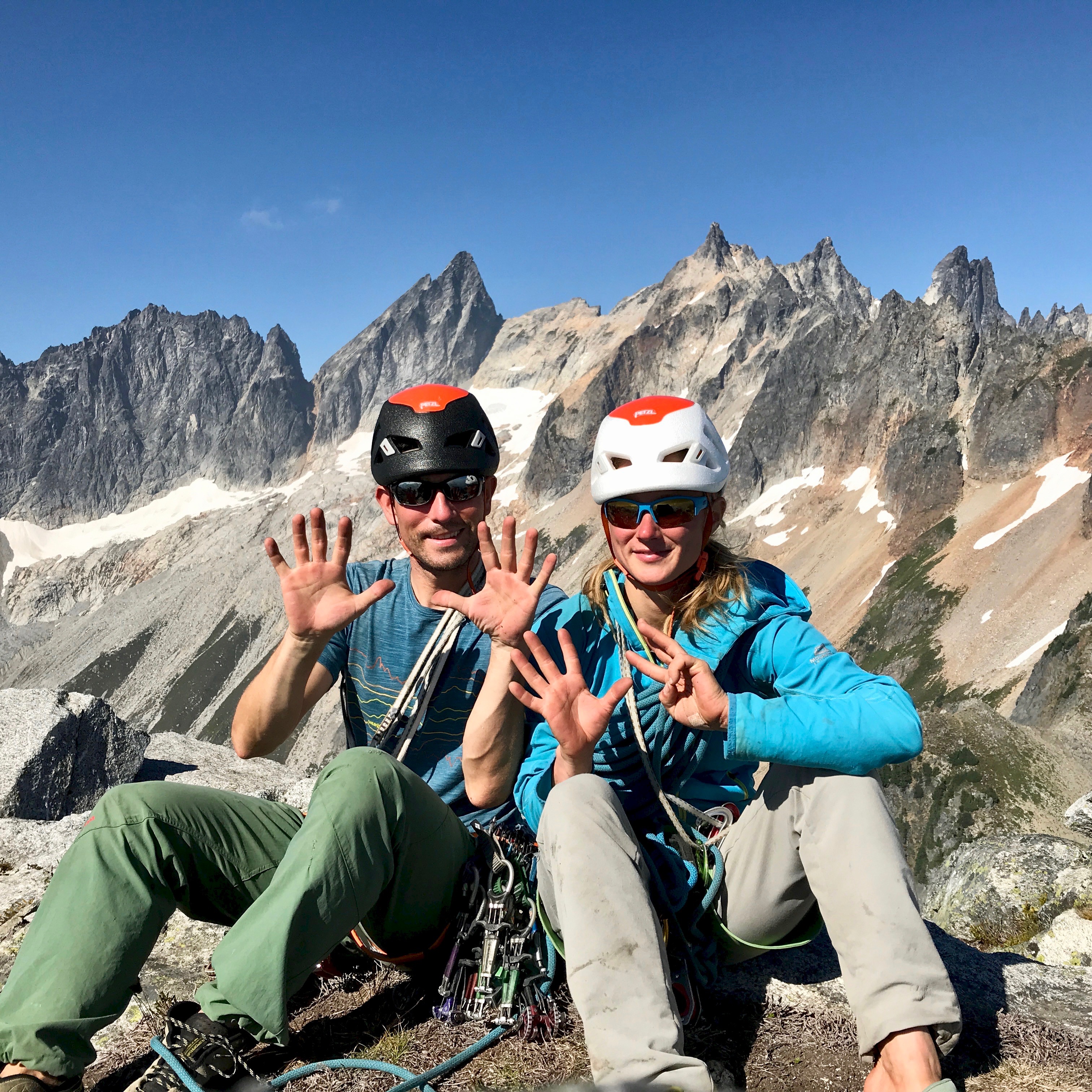
Retirement/Savings Plan
[Homer Simpson: “BORING”] If you already have a retirement goal, understand how the sabbatical will affect your retirement account, if at all. If you don’t have a goal, do this now! Will this affect your retirement date? If you were planning to retire early, maybe you now need to work a few more years. Consider the time value of money: One year of not working when you’re 30 doesn’t necessarily mean that you’re taking one equal year away from your retirement age. If you have no idea about retirement, consider seeing a Certified Financial Planner to run retirement scenarios for you. Maybe you decide it’s ok to reduce your current retirement contributions. Alternatively, you can decide to not change your contributions at all, and furthermore factor into your budget retirement account contributions during your gap year.

Partners
We’re lucky enough to have each other as legally bound climbing and travel partners. If you’re flying solo, or have friends meeting you intermittently, fear not! It’s surprisingly easy to find climbing partners abroad. Just remember that with new partners, it’s especially important to establish your Goals-Expectations-Style ahead of time. Make sure they know how to tie a figure 8 before you show up at the base of an alpine route!
Give Back
Find a good charity to support while on your adventures, and seek out volunteer opportunities. Maybe you’re supporting re-bolting efforts in Thailand, or local schools in Nepal, or mountain rescue operations in Patagonia. Remember, this is a Sabbatical, and it’s more than a vacation. Use this time to enrich your life and the lives of others.

For our particular 2020 itinerary, we’ll be in Patagonia for two months, Chamonix for three months, Pakistan for three months, then India, Thailand and Laos (to clip some bolts as we decompress from alpine pursuits). Follow along if you like on the Insta: @jeff_t_wright and @prittyright. This blog post was written specifically for Feathered Friends, to follow a presentation we had the wonderful opportunity to give at the Seattle location.
